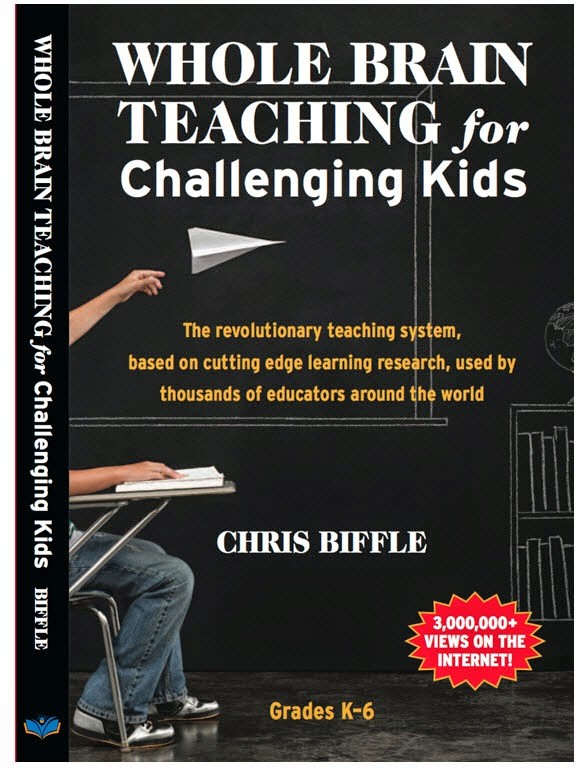 Guest post by Chris Biffle
Guest post by Chris Biffle
Director, Whole Brain Teaching
WBT Rule 1: Follow Directions Quickly
Please don’t read this, unless you have medical clearance. Make sure your doctor guarantees that your ticker can take the thrill of watching your class zip, with lightning speed, from one activity to another.
When my teaching colleagues and I, 20 years ago, were designing the fundamentals of Whole Brain Teaching, we had no problem agreeing that Rule 1, for classroom management, should be “Follow directions quickly!” Slow transitions from reading to writing to math to lining up, not only wasted time, but also were breeding grounds for disruptive activity. If, for some nightmarish reason, you wanted an out of control classroom, encourage slow, lazy transitions and bingo … your kids will be bouncing off the walls.
Ponder these truths. Kids open their books slowly because we never take time to teach them to open their books quickly. Kids take forever to get out a piece of paper and write their names in the corner because we have never taught them to do this rapidly. Kids, day after day, week after week, line up in wacky fashion because the only time we teach them how to line up is when they are actually lining up … which is precisely when we have no time to teach anything!
Teaching Kids to Follow Directions Quickly
Here is a simple, two step procedure, classroom tested by tens of thousands of teachers, for helping your kids to follow directions quickly. If you would like a visual to display in your classroom, you can download the poster shown above from TpT as a part of a free set of posters created for this blog post series.
Step One: Vigorously rehearse Rule 1, five times a day. You say, “Rule 1” and hold up one finger. Your kids say, “Follow directions quickly!” and rapidly swim one hand through the air, like a trout darting upstream. Do not go to Step Two until your kids instantly respond, merrily respond!, to your Rule 1 cue. The more entertaining you make this rehearsal, the more engaged your students will be in following the rule. One of our mottos at WBT: students learn the most when they are having the most fun learning.
Step Two: Teach your kids the Three-Peat. You say, “Math book 14!” They say, “Math book 14, Math book 14, Math book 14!” as they open their math books to page 14. When the book is open to the correct page, your children should shoot both hands upward, waggle their fingers, and happily murmur, “Yea!” They continue their celebration, until you sweep your hand dramatically through the air. Use the celebration time to help students who are a bit slow.
Using the Three-Peat, if you say, “Names on paper!,” your kids exclaim, “Names on paper, names on paper, names on paper!” After they have written their name, they celebrate until you signal it is time for silence.
Listen to me my dear colleague! Don’t try to teach lining up right before the bell rings. You don’t have time. Rehearse lining up five times a day, when you are not fighting the clock. You say, “Lines!” Your kids exclaim, “Lines! Lines, Lines!” and line up according to the pattern you have established. You say “Seats!” and they exclaim, “Seats! Seats! Seats!,” celebrating when they are sitting down. For extra motivation, time these activities with a stopwatch. Then, as you gasp in delight, watch as your kids race to set new, transition records.
Doesn’t this make sense? The more you rehearse any procedure, and the more entertaining you make the rehearsal, the quicker your kids will perform a classroom transition.
Please calm down. A rapidly beating heart is a sure sign you are approaching Teacher Heaven.
 For a complete description of Whole Brain Teaching’s rules, see chapter 7 in “Whole Brain Teaching for Challenging Kids” available on Amazon.com.
For a complete description of Whole Brain Teaching’s rules, see chapter 7 in “Whole Brain Teaching for Challenging Kids” available on Amazon.com.
Chris Biffle
Director, Whole Brain Teachers of America
Website: WholeBrainTeaching.com
Facebook | Twitter | Youtube | WBT Bookclub | Webcast Archive
Chris Biffle, a college philosophy professor for 40 years, is the author of seven books (McGraw-Hill, HarperCollins) on critical thinking, reading and writing. He has received grants from the U.S. Department of Education and the National Endowment for the Humanities. In the last 15 years, Chris has been lead presenter at over 100 Whole Brain Teaching conferences, attended by 20,000+ educators. Thousands of instructors across the United States and around the world base their teaching methods on his free ebooks available at WholeBrainTeaching.com.